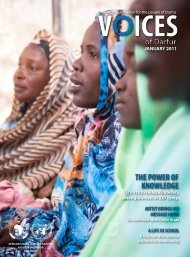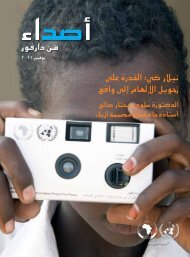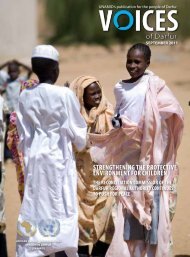Darfur Dances
Download the magazine (PDF) here. - Unamid
Download the magazine (PDF) here. - Unamid
- No tags were found...
Create successful ePaper yourself
Turn your PDF publications into a flip-book with our unique Google optimized e-Paper software.
CULTURE<br />
Khatir: Only some of dances require<br />
lots of training, such as the<br />
dances for war. These dances involve<br />
complicated movements that can’t be<br />
learned quickly. Some other dances<br />
are quite easy, such as those for weddings<br />
or harvests.<br />
As for the age of dancers, there are<br />
some issues with certain dances. We have<br />
dances that could be dangerous. In dances<br />
for war, the dancers carry sharp weapons<br />
called Kurbaj. The dancers should<br />
not touch each other during the performance.<br />
If one dancer touches another,<br />
the consequences could be disastrous.<br />
Thus, the dancers should have a high<br />
level of skill in performing this dance.<br />
This skill comes only with practice and<br />
age. So young men, naturally, haven’t had<br />
enough time to practice that dance and<br />
are not encouraged to perform it.<br />
VoD: Are there <strong>Darfur</strong>i dances for<br />
women only?<br />
Khatir: There are women’s dances,<br />
such as those for wedding and henna occasions.<br />
These dances are done inside homes<br />
where only women can watch. There are<br />
other dances where both men and women<br />
can participate. But most of <strong>Darfur</strong>i traditional<br />
dances are done by men, probably<br />
because the society here is conservative.<br />
Men’s dances are usually performed outdoors<br />
where anyone, including men, women<br />
and children, can watch.<br />
VoD: What about costumes? Does<br />
each dance have a certain outfit associated<br />
with it?<br />
Khatir: Costumes usually match the<br />
movements in a certain dance. For example,<br />
dancers wear long trousers for a<br />
dance called Juju, while in other styles<br />
the dancers wear suits. And in many<br />
dances, the outfit is the Galabiya and<br />
Imma, the traditional body and head attire<br />
commonly worn in Sudan.<br />
VoD: Are traditional dances for war<br />
still practised in some areas in <strong>Darfur</strong>?<br />
Khatir: Only to a certain extent because<br />
of the traditions in <strong>Darfur</strong> and due<br />
to some conflicts that still happen among<br />
some tribes. So there are still some war<br />
dances that are carried out with songs<br />
that urge people to defend their lands in<br />
case of disputes with other tribes. Some<br />
other dances are done to urge people to<br />
defend their honour.<br />
On 10 October 2013 in El Fasher, North <strong>Darfur</strong>, Mr. Elfadhil Khatir, a lecturer at the University of El<br />
Fasher, offers guidance on traditional <strong>Darfur</strong>i dance to members of the Sarafi drama group at the<br />
El Fasher Cultural Centre in El Fasher, North <strong>Darfur</strong>. Photo by Albert González Farran, UNAMID.<br />
“This deeply rooted art in <strong>Darfur</strong>’s societies can<br />
effectively contribute to promoting peace among<br />
tribes. New group dances could be designed by<br />
mixing movements from different tribes.”<br />
Generally, war dances are not popular<br />
in <strong>Darfur</strong> any longer, and people are<br />
not affected by them due to the overall<br />
willingness among <strong>Darfur</strong>is to work toward<br />
peace and peaceful coexistence.<br />
VoD: In general, are the traditional<br />
dances still practiced widely in<br />
<strong>Darfur</strong>’s cities and villages in comparison<br />
with the past years?<br />
Khatir: Unfortunately, many traditional<br />
dances are not practiced as often<br />
as in the past, before the conflict. The<br />
reason for this is that lots of people<br />
were displaced due to the conflict and<br />
have been going through tough times.<br />
So many tribal communities have had<br />
to abandon their dances, as they don’t<br />
have the luxury of free time to practice.<br />
Many families and entire communities<br />
are struggling merely to stay<br />
alive. But there are many areas where<br />
traditional dances are still performed,<br />
especially the areas that have good security<br />
around the main cities with sizeable<br />
populations.<br />
VoD: Do you think new group<br />
dances could be designed by <strong>Darfur</strong>’s<br />
young people to help promote peace<br />
and reconciliation?<br />
Khatir: Definitely. This deeply<br />
rooted art in <strong>Darfur</strong>’s societies can<br />
effectively contribute to promoting<br />
peace and reconciliation among tribes.<br />
New group dances could be designed<br />
by mixing movements from different<br />
tribes. These dances could involve<br />
symbolic movements expressing unity<br />
and brotherhood among these groups.<br />
Such a project could indeed be implemented<br />
by the musicians and dancers<br />
here to reflect the need of the young<br />
people in <strong>Darfur</strong> to have a better life.<br />
A better life can’t be achieved through<br />
war, but rather through social peace<br />
and prosperity.<br />
Artistically, traditional dances could<br />
be transformed into new, contemporary<br />
styles to promote peace and social development.<br />
Such dances could be performed<br />
during happy occasions that are<br />
typically attended by large audience.<br />
VoD: Finally, what is the message<br />
you would like to send to all <strong>Darfur</strong>is?<br />
Khatir: I would like to tell them that<br />
social unity, not dispersion and division,<br />
is the basis of good life. So let’s unite to<br />
have one country for all of us, regardless<br />
of race, religion or colour.<br />
V<br />
28 VOICES OF DARFUR • NOVEMBER 2013








